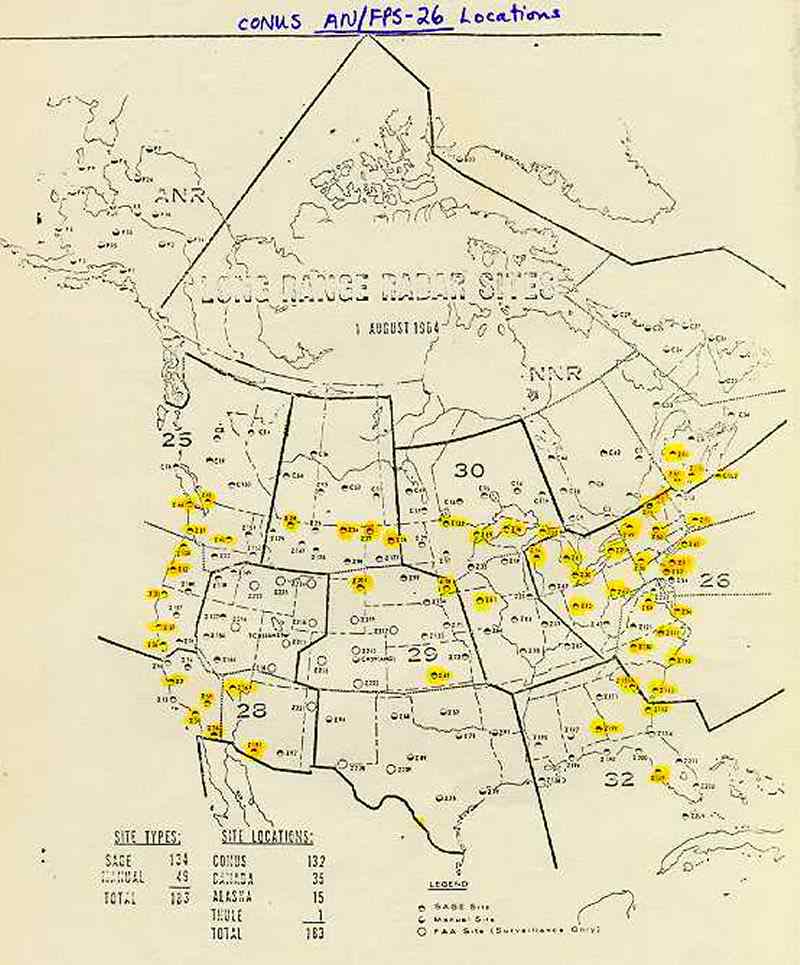AN/FPS-26
Avco Corporation built this height-finder radar that operated at a frequency of 5400 to 5900 MHz. This radar deployed in the 1960s.
|
The AN/FPS-26 antenna pictured at right is now a static display at Gibbsboro AFS, NJ, where this radar once operated. |
|
|
The FPS-26 antenna pictured at right is from Roanoke Rapids, NC. |
|
|
The receiver area of the FPS-26 at Roanoke Rapids, NC. |
|
|
The transmitter area of the FPS-26 at Roanoke Rapids, NC . |
|
|
The antenna drive units consisted of a three-phase ac motor driving a hydraulic pump. The pump could be adjusted for a pressure of approximately 3000 psi. The elevation drive unit pumped fluid under pressure to the nod-rod. The nod-rod in turn moved the radar antenna in a sweeping or nodding (up-down) fashion. Their were limits to both upper and lower movement. The azimuth drive unit could position the antenna to any position in a matter of seconds. |
|
|
The AN/FPS-26A tower had three floors. The first floor contained most of the receiver cabinets to include receiver monitors, waveguide pressurizer, 28 V power supply, heat exchangers for the two transmitters, and incoming power distribution equipment. A staircase took you to the second floor where these photos were taken. The first photo shows transmitter # 1, left side with doors off and drawers open. The pictures were taken during armed forces day during May of 1978. The transmitter was completely powered down and roped off so the public could take a peak inside. Transmitter 2 was up and on the air putting out a minimum of 2 MW (mega wat ts) of pulsed RF energy at a frequency between 5.4 to 5.9 GHz (giga hertz).From left to right the cabinets were indentified as numbered unit(s) 34, 35, 36, 37, 38, and 39. By name you have the master oscillator cabinet (34), driver cabinet (35), power amplifier (36), modulator (37), high voltage power supply (38), and power distribution (39). |

|
|
The 26A transmitter, rear view. The units shown are 34/35/36 and 36 alone. Moving right to left unit 34 exposes the upper tray containing the assembly housing the backward wave oscillator (BWO). The BWO generated the 5.4 to 5.9 GHz operating frequency of the transmitter. The lower part of the photo shows a cooling fan. The output from unit 34 was coupled to 35. Unit 35 was referred to as the driver cabinet and contained a microwave amplifier called a traveling wave tube (TWT). You can see two chassis assemblies as well as another cooling fan. The TWT amplified the output from the BWO and coupled the signal to unit 36. Unit 36 provided final amplification of the transmitter signal and was called the power amplifier stage. The second photo of this set shows unit 36 or the power amplifier stage. Unit 36 provided amplification through the use of a high power klystron tube (shown in red on the right side of the photo). The upper portion of the klystron can be see, the lower half is sitting inside the focus coil assembly. Both the klystron and focus coil assembly and bolted to the top of a pulse transformer (black area) which provided a high-voltage pulse to the cathode of the klystron. The process of producing RF energy at high power levels is a little more detailed than I am describing. I remember the klystron as bring manufactured by Varian and worth about $10,000. at the time. We could usually get 12 to 18 months of use from one until the power output began to drop below an acceptable level of about 2 Mw (2,000,000 watts). A klystron could be removed and replaced in a couple of hours. The pulse transformer was different. The thing weighed about 1000 pounds and took several maintenance techs several hours to safely remove and replace. A track system with chain hoist was bolted to the ceiling above each transmitter. It was used in the removal and replacement of the heavy items. A cooling fan and holding tank for insulating oil for the transformer can also be see. Front panel meters and wiring can also be seen on the far side of the cabinet. |
|
|
This transmitter photo shows a section of 37, 38, and a part of 39. Moving right to left you can see a small section of the modulator, unit 37. A single cooling fan can be seen at the bottom. The assembly above the fan is a large vacuum tube called a thyratron. It was used as a special type of fast acting switch that provided a discharge path for the pulse forming network (PFN), a bank of large capacitors not seen in this picture. The high voltage electrical pulse from the PFN was applied to the pulse transformer in unit 36. The electrical energy for the PFN was provided by unit 38, the high-voltage power supply. In this part of the picture you can see several capacitors and inductors. Connections between components were made through many wires and standoffs seen at the top of the picture. Two cooling fans can be seen at the bottom. As previously mentioned, before the transmitter would operate all doors and drawers had to be closed. A series of "interlock" switches in units 34 through 38 had to be closed before the transmitter could be put into radiate. This protected the technician from serious injury or death under normal circumstances. On the far left of the photo you can see the back of unit 39. The cabinet was used for power distribution and contained a series of large bus bars and front panel indicator lights. |
|










